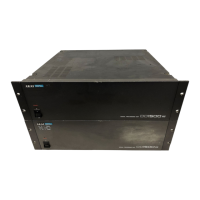DD1000 DISK COMPATIBILITY - 25
Version 2.00 - March, 1996 Page 277
The DD1500, however, says:
“Play [TAKE N] from the disk with the unique label #XXXXXXXX”
DD1000 disks, however, do not have the concept of disk labels and so to overcome this,
the DD1500 will automatically write a label to the DD1000 disk, thereby giving it something
it can work from given the above statement In this way, it doesn’t matter which drive the
disk is in - the DD1500 is looking for the disk label, not the SCSI ID. It will find this and so it
will play back correctly regardless of the drive the disk is in.
NOTE: Please note that for the label to be written to the DD1000 disk, the write protect
switch must be off. If the disk is write protected, the label can’t be written. In this case, the
DD1500 uses the same logic as the DD1000 (i.e. Play [TAKE N] from the disk in the drive
with the SCSI ID#X) and you will have to make sure that the disk is in the correct drive.
Furthermore, if a DD1000 Qlist has audio that exists on one disk only (as is invariably the
case), the DD1500 assumes that the audio is on the same disk as the Qlist and so it will
also play back properly.
However, please note the following restrictions when taking a DD1000 disk from a DD1500
back to a DD1000:
• When a converted DD1000 Qlist is saved as a project on the DD1500, in the DD1000
Qlist that is also created, the DD1500 resets all the cues’ SCSI IDs to be the same as
the drive it was played from on the DD1500 (i.e. if you played the project on drive #4,
all the cues will be reset to have a SCSI ID of #4). This means that the disk must be
either be saved on an appropriately numbered drive on the DD1500 or the disk must
be used in a drive with the correct SCSI ID when you take it back to the DD1000 or
you must edit each cue separately in the DD1000.
• If the DD1000 Qlist’s audio comes from more than one disk, then the original situation
remains and the disks must be placed in the correct drive in order to play back
correctly.
It must be said that this all sounds terribly complicated. The fact is, it is! However, this is
included to make the transfer of disks between the two machines as easy as possible. In
the majority of cases, you will have a simple 2- or 4-track Qlist on one DD1000 disk which
you can take to the DD1500, work on it there and (assuming you don’t try to add a further
6 tracks of material!!) you can take it back to the DD1000 and play it there. Only in the
case where you may bring multiple disks from a multiple drive DD1000 system to a
multiple drive DD1500 system should you need to concern yourself with the above.

